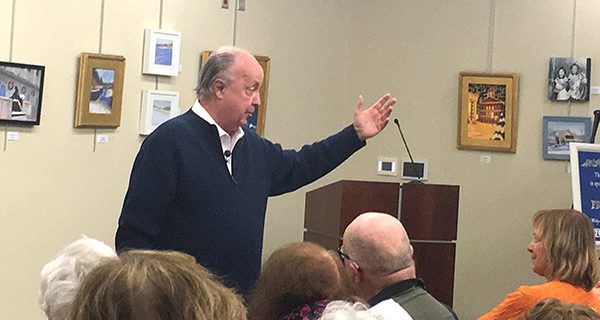[ccfic caption-text format="plaintext"]
By Katrina Margolis
Hometown Weekly Reporter
An absolute classic, it is nearly impossible to get through the holiday season without some version of Charles Dickens’ ‘A Christmas Carol.’ Whether it’s the actual novella, or one of the many film adaptations including traditional renderings, comedic approaches such as ‘Scrooged,’ or even animated versions like ‘Mr. Magoo’s A Christmas Carol.’ This past Monday at the Walpole Public Library, Professor Gary Hylander of Stonehill College gave a presentation of parts of the original novella, with historical context and facts to boost.
Presented by the friends of the Walpole Library, Hylander has made a number of presentations including the landing of the Pilgrims and the history of the Supreme Court. Hylander burst into the room proclaiming, “Bah Humbug!” to an uproar of laughter.
An engaging and high energy speaker, before reading bits of the story, Hylander set the scene. “Everyone celebrates Dickens - it’s Dickens who gives us ‘bah humbug,’ it’s Dickens who gives us the phrase ‘merry Christmas.’ In his first drafts, it had been ‘happy Christmas’ and he is able to flip it to Merry Christmas,” Hylander explained. “And Dickens gives us the unforgettable character of Ebenezer Scrooge, and we use that, don’t we? ‘He’s a Scrooge, she’s a Scrooge.’”
One of the most interesting facts Hylander presented is where the name Scrooge even came from. “His two richest veins of names - one was he would go through the obituaries and collect names that were interesting. And he also wandered through cemeteries with his pencil and notebooks, and that’s where he got Ebenezer Scrooge - talk about the mother-load! I can just see Dickens saying ‘Look at that, I need that.’”
The beauty of ‘A Christmas Carol’ is that is has reached a level of ubiquity that even if you have not read it, the lessons and messages presented are known. Hylander explained this aspect of the novel a little further. “The beauty of a novella is one can speak to a lesson, and the take home story, the take-home lesson is sharing, empathy, charity and redemption,” he said. “And I do not mean redemption on the other side of the stars, and neither was he. He’s talking about redeeming your selfishness. He puts a real name, a face to the poor.”
The story truly speaks to the messages and heart of Christmas. “For Dickens it’s not about gifts. It’s about food, it’s about conversation, it’s about sweet words. It’s a human story. It’s about caring and sharing and knowing there are others beyond that warm, crackling fire in the hearth.”






















